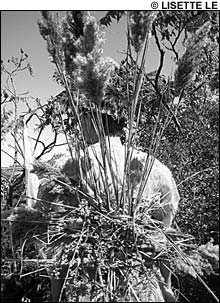
DOWN TO EARTHY: The Camofleurs combined natural disguises with, they claimed, bird nesting practices. |
“I am curating for the event! Would anyone switch with me?”That was the plea from a woman who, for safety reasons this past Sunday, was asked to give up her space on the boat taking us to the Art Encampment on Bumpkin Island. We were aboard an inter-island shuttle, commissioned to relay mainland passengers from George’s Island to Bumpkin. It was not the most convenient of locations for an art event.
Then again, isolation was part of the challenge. Ten teams of artists effectively marooned themselves on the Boston Harbor island from Thursday, August 28, through Monday, September 1, with only whatever art and survival supplies they could carry with them. Their mission in exile was to create “site-specific” performances or installations.
In Erik Conrad’s case, the remote site forced him to mine unexplored artistic territory. Conrad, wearing a suit as he manned his Tactilist Theater booth, explained that on the mainland he works with computers. But inside his tent he’d assembled a vast collection of local flora, fauna, and natural artifacts, scattered purposefully around the interior. He escorted me through his installation with my eyes closed, running my hands over the stuff. It was the sort of thing you’d find at any number of children’s museums, but way cooler, I decided, because he had put it all together from scratch.
Not long after, I ran into the Camoufleurs, a troop of artists wandering around the island in “earth outfits” made from scavenged local materials, including feathers and berries. According to a guide pamphlet I’d received, their work combined “military concealment strategies” used during World War II with “bird nesting practices.” To what end, I wasn’t sure, so I ventured to talk to these strange folks. “Why are you dressed that way?” I asked. “Why are you dressed that way?” came the rejoinder from a man with stalks of sweet grass rising from his shoulders. Fair enough, I resigned myself to concede, and didn’t push the issue.
Next I ducked into an installation called the Honorable Bumpkin Island Company, which was closed for lunch. I snooped around the makeshift structure and found an assortment of goods to be bartered: Hershey bars, canned soups, Ramen noodles. On the wall I spied a copy of the Saturday edition of the handwritten island newspaper, the Bum-kin Islander. Stories included a weather report, an alert to a bike heist, and a news item concerning a fruit-cocktail shortage.
Hitching a boat ride home, I tried to put my finger on the appeal of this Encampment thing. More compelling than the art itself, I reasoned, was how the “homesteaders” had, during the course of a long weekend, managed to conjure a vibrant community out of thin air. It was a pity that these artists would soon pull a “Roanoke” and the island would go silent once more.